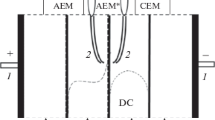Abstract
Single-pulse and double-pulse chronopotentiograms of a homogeneous anion-exchange membrane AX in 0.02 M solutions of NaCl (system 1) or NaH2PO4 (system 2) have been recorded in underlimiting and overlimiting current modes. It has been found that in the case of exceeding the limiting current (i > i Levlim ) calculated using the convection–diffusion model, the time required to establish a steady state in system 2 increases by more than an order of magnitude compared to system 1. The slow growth of the potential drop is due to a gradual transition of the membrane from the form in which the main counterion is H2PO –4 to the HPO 2–4 form. This transition is due to the deprotonation of a part of H2PO –4 ions forming HPO 2–4 and protons as they enter the membrane. The participation of H+ in charge transfer in the depleted diffusion layer at a given current density causes a lower value of the potential drop than in system 1 for the same i/i Levlim ratio. In intense current regimes, chronopotentiograms of system 2 exhibit two inflection points. The first point corresponds to the classical Sand transition time and is due to reaching the limiting current of H2PO –4 ions (the main charge carrier for i < i Levlim ) in the depleted diffusion layer. The second point is associated with a critical current that can be called the second limiting current in the system with NaH2PO4 and has no analogue in the system with NaCl. This current, which is approximately 2i Levlim , corresponds to the state when the membrane is completely transformed into the HPO 2–4 form. Meanwhile, the source of protons due to the transformation of H2PO –4 into HPO 2–4 ions as they enter the membrane is exhausted. After reaching this critical value of the potential drop, either the HPO 2–4 deprotonation reaction to give triply charged PO 3–4 ions in the membrane or the water splitting on fixed groups located at the membrane/solution interface may occur.
Similar content being viewed by others
References
R. He, A. T. Girgih, E. Rozoy, et al., Food Chem. 197, 1008 (2016).
G. Chen, W. Song, B. Qi, et al., Sep. Purif. Technol. 147, 32 (2015).
J. Xu, X.-F. Su, J.-W. Bao, et al., Bioresour. Technol. 189, 186 (2015).
V. A. Shaposhnik and T. V. Eliseeva, J. Membr. Sci. 161, 223 (1999).
T. V. Eliseeva, E. V. Krisilova, V. P. Vasilevsky, and E. G. Novitsky, Pet. Chem. 52, 609 (2012).
M. Metayer, M. Legras, O. Grigorchouk, et al., Desalination 147, 375 (2002).
T.V. Eliseeva and V. A. Shaposhnik, Russ. J. Electrochem. 36, 64 (2000).
V. I. Vasil’eva and E. A. Vorob’eva, Russ. J. Phys. Chem. A 86, 1852 (2012).
E. A. Vorobjeva and V. I. Vasil’eva, Sorb. Khromatogr. Protsessy 10, 741 (2010).
V. Sarapulova, E. Nevakshenova, N. Pismenskaya, et al., J. Membr. Sci. 479, 28 (2015).
P. Ramirez, A. Alcaraz, and S. Mafe, J. Colloid Interface Sci. 242, 164 (2001).
L. Franck-Lacaze, P. Sistat, and P. Huguet, J. Membr. Sci. 326, 650 (2009).
F. Helfferich, Ionenaustauscher, Bd. 1: Grundlagen Struktur-Herstellung-Theorie (Chemie, Weinheim, 1959).
R. Lteif, L. Dammak, C. Larchet, and B. Auclair, Eur. Polym. J. 35, 1187 (1999).
E. D. Belashova, N. A. Melnik, N. D. Pismenskaya, et al., Electrochim. Acta 59, 412 (2012).
V. V. Gil, M. A. Andreeva, N. D. Pismenskaya, et al., Pet. Chem. 56, 440 (2016).
N. P. Berezina, N. A. Kononenko, O. A. Dyomina, and N. P. Gnusin, Adv. Colloid Interface Sci. 139, 3 (2008).
J. S. Newman, Electrochemical Systems (Prentice Hall, New York, 1973).
N. P. Gnusin, V. I. Zabolotsky, V. V. Nikonenko, and M. K. Urtenov, Russ. J. Electrochem. 22, 298 (1986).
J. J. Krol, M. Wessling, and H. Strathmann, J. Membr. Sci. 162, 155 (1999).
E. D. Belashova, N. D. Pismenskaya, V. V. Nikonenko, et al., J. Membr. Sci. 542, 177 (2017). doi.org/10.1016/j.memsci.2017.08.002
H. Roques, Fondements théoriques du traitment chimique des eaux, in two vols. (Lavoisier, Paris, 1990).
D. R. Lide, CRC Handbook of Chemistry and Physics (CRC, Boca Raton, 1995).
N. Pismenskaya, E. Laktionov, V. Nikonenko, et al., J. Membr. Sci. 181, 185 (2001).
N. Pismenskaia, P. Sistat, P. Huguet, et al., J. Membr. Sci. 228, 65 (2004).
S. A. Mareev, D. Yu. Butylskii, N. D. Pismenskaya, and V. V. Nikonenko, J. Membr. Sci. 500, 171 (2016).
V. I. Zabolotsky, N. V. Sheldeshov, and N. P. Gnusin, Russ Chem. Rev. 57, 501 (1988).
E. I. Belova, G. Yu. Lopatkova, N. D. Pismenskaya, et al., J. Phys. Chem. B 110, 13458 (2006).
N. D. Pismenskaya, V. V. Nikonenko, E. I. Belova, et al., Russ. J. Electrochem. 43, 307 (2007).
L. A. Zagorodnykh, O. V. Bobreshova, P. I. Kulintsov, and I. V. Aristov, Russ. J. Electrochem. 42, 59 (2006).
I. Rubinstein and B. Zaltzman, Phys. Rev. E: Stat. Phys., Plasmas, Fluids, Relat. Interdiscip. Top. 62, 2238 (2000).
I. Rubinstein, B. Zaltzman, A. Futerman, et al., Phys. Rev. E: Stat. Phys., Plasmas, Fluids, Relat. Interdiscip. Top. 79, 021506 (2009).
E. A. Shutkina, E. E. Nevakshenova, N. D. Pismenskaya, et al., Kondens. Sredy Mezhfaz. Granitsy 17, 566 (2015).
Author information
Authors and Affiliations
Corresponding author
Additional information
Original Russian Text © E.D. Belashova, O.A. Kharchenko, V.V. Sarapulova, V.V. Nikonenko, N.D. Pismenskaya, 2017, published in Membrany i Membrannye Tekhnologii, 2017, Vol. 7, No. 6, pp. 384–397.
The article was translated by the authors.
Rights and permissions
About this article
Cite this article
Belashova, E.D., Kharchenko, O.A., Sarapulova, V.V. et al. Effect of Protolysis Reactions on the Shape of Chronopotentiograms of a Homogeneous Anion-Exchange Membrane in NaH2PO4 Solution. Pet. Chem. 57, 1207–1218 (2017). https://doi.org/10.1134/S0965544117130035
Received:
Published:
Issue Date:
DOI: https://doi.org/10.1134/S0965544117130035




